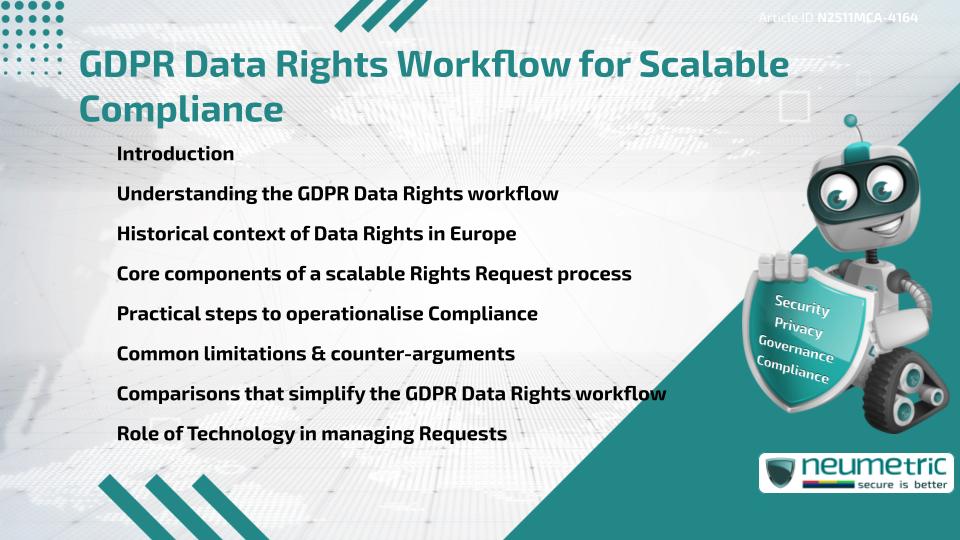Table of Contents
ToggleIntroduction
A GDPR Data Rights workflow is a structured method that organisations use to handle Data Subject Rights Requests in a consistent & compliant way. It covers intake, verification, validation, fulfilment & communication. A well-built GDPR Data Rights workflow helps teams respond within statutory timelines, avoid errors, document decisions & maintain transparency. It also ensures that individuals can exercise their rights to access, rectification, erasure, restriction, objection & portability. This article explains how the GDPR Data Rights workflow emerged, what it includes, how it operates at scale & why practical processes matter for compliance.
Understanding the GDPR Data Rights workflow
A GDPR Data Rights workflow acts like a guided path that takes a Rights Request from the moment a person submits it to the point where the organisation sends the final response. Every step contributes to accuracy & fairness because the workflow reduces informal handling & human error. Independent regulators such as the European Data Protection Board (https://edpb.europa.eu) publish guidance that emphasises clarity & traceability across each stage.
Standard workflows usually include:
- Intake through email, webform or postal request
- Verification to confirm identity
- Validation to check the legitimacy of the request
- Retrieval & review of relevant information
- Decision-making & redaction
- Response issuance & recordkeeping
This structure ensures that even high-volume environments maintain consistency.
Historical context of Data Rights in Europe
The origin of modern Rights Requests goes back to the 1995 Data Protection Directive (https://eur-lex.europa.eu). The General Data Protection Regulation expanded these rights & placed greater emphasis on accountability. Public agencies & Data Protection Authorities encouraged clearer communication because early research from EU institutions (https://europa.eu) showed that many individuals were unaware of their rights. The modern GDPR Data Rights workflow therefore reflects decades of refinement around fairness & transparency.
Core components of a scalable Rights Request process
A scalable workflow divides tasks into concise units so teams can assign ownership. The goal is to ensure that as request numbers grow no single person becomes a bottleneck.
Key elements include:
- Unified intake channels to avoid misplaced requests
- Standard templates for verifying identification
- Clear rules for identifying what data qualifies for disclosure
- Central tracking systems
- Time-based alerts to avoid missed deadlines
- Structured communication templates
This structure enables repeatability across multiple departments & reduces inconsistent practices.
Practical steps to operationalise Compliance
Organisations often begin by mapping where Personal Information sits. Without an inventory teams may struggle to locate data quickly. The next step is training staff so they know how to classify requests & when to escalate them. Public bodies such as the UK Information Commissioner’s Office (https://ico.org.uk) offer helpful guidance on training practices.
Another step is setting up a secure channel for identity verification because organisations must avoid disclosing information to the wrong person. Finally teams should record decisions so future audits can understand why the organisation accepted or rejected a request.
Common limitations & counter-arguments
Some argue that heavy workflows slow down internal operations. Others suggest that automation alone could replace manual checks. However organisations still need human review for context & accuracy. Regulators emphasise that automated tools must not produce unfair outcomes. Balanced practice therefore includes automation for routine steps & human judgement for sensitive decisions.
Comparisons that simplify the GDPR Data Rights workflow
A simple analogy is a library returns desk. When a person returns a book the librarian checks identity, reviews the item, confirms whether conditions are met & records the action. The GDPR Data Rights workflow follows a similar pattern. Structured steps prevent mistakes & ensure fairness across all individuals.
Role of Technology in managing Requests
Technology scales the process by handling common tasks such as intake routing, deadline monitoring & documentation. Even so teams must configure tools with care. Independent organisations such as EU Ombudsman (https://www.ombudsman.europa.eu) highlight the importance of clarity & accessibility which technology alone cannot guarantee.
Takeaways
- A GDPR Data Rights workflow protects individuals & organisations through clarity, traceability & consistency.
- Scalable processes rely on accurate data inventories, trained staff & well-defined steps.
- Balanced use of automation improves efficiency without replacing essential human judgement.
FAQ
What is a GDPR Data Rights workflow?
It is a structured process that guides how organisations receive, review & respond to Rights Requests.
Why does workflow clarity matter?
Clear steps prevent errors, ensure fairness & help organisations meet statutory timeframes.
How long should a Rights Request take?
The Standard period is one (1) month although extensions may apply for complex Requests.
Should organisations verify identity for all Requests?
Yes, identity verification prevents unauthorised disclosure.
Can automation handle the entire workflow?
Automation helps but human review is needed for sensitive or complex situations.
Do organisations need to record each decision?
Yes, documented reasoning supports accountability & Audit requirements.
Is a single intake channel enough?
Most organisations benefit from multiple channels as long as they route into one unified system.
Are individuals always entitled to erasure?
Not always. Legal obligations or overriding interests may limit the right.
Does the workflow apply to all controllers?
Yes, all controllers must provide a consistent response process.
Need help for Security, Privacy, Governance & VAPT?
Neumetric provides organisations the necessary help to achieve their Cybersecurity, Compliance, Governance, Privacy, Certifications & Pentesting needs.
Organisations & Businesses, specifically those which provide SaaS & AI Solutions in the Fintech, BFSI & other regulated sectors, usually need a Cybersecurity Partner for meeting & maintaining the ongoing Security & Privacy needs & requirements of their Enterprise Clients & Privacy conscious Customers.
SOC 2, ISO 27001, ISO 42001, NIST, HIPAA, HECVAT, EU GDPR are some of the Frameworks that are served by Fusion – a SaaS, multimodular, multitenant, centralised, automated, Cybersecurity & Compliance Management system.
Neumetric also provides Expert Services for technical security which covers VAPT for Web Applications, APIs, iOS & Android Mobile Apps, Security Testing for AWS & other Cloud Environments & Cloud Infrastructure & other similar scopes.
Reach out to us by Email or filling out the Contact Form…


